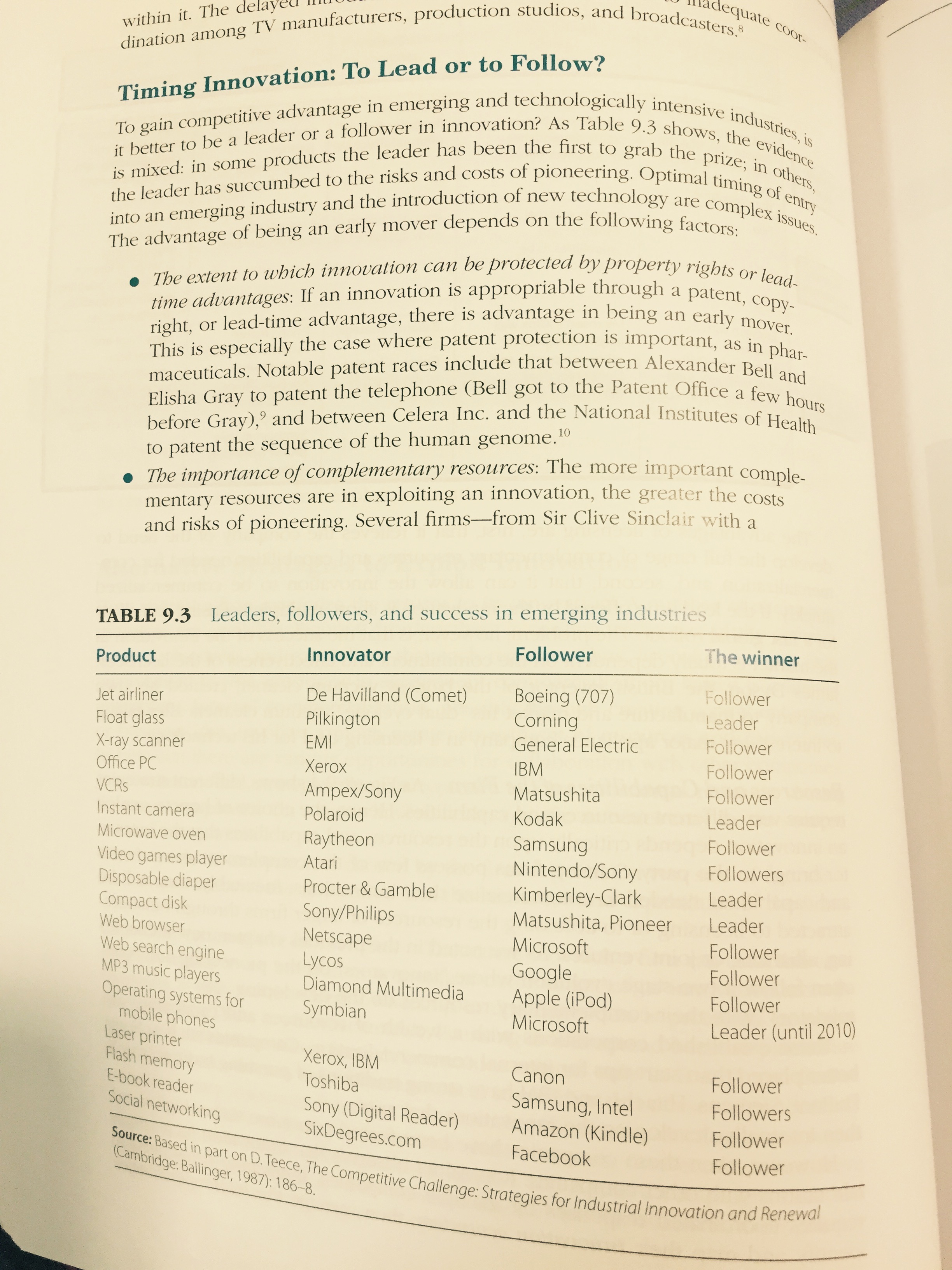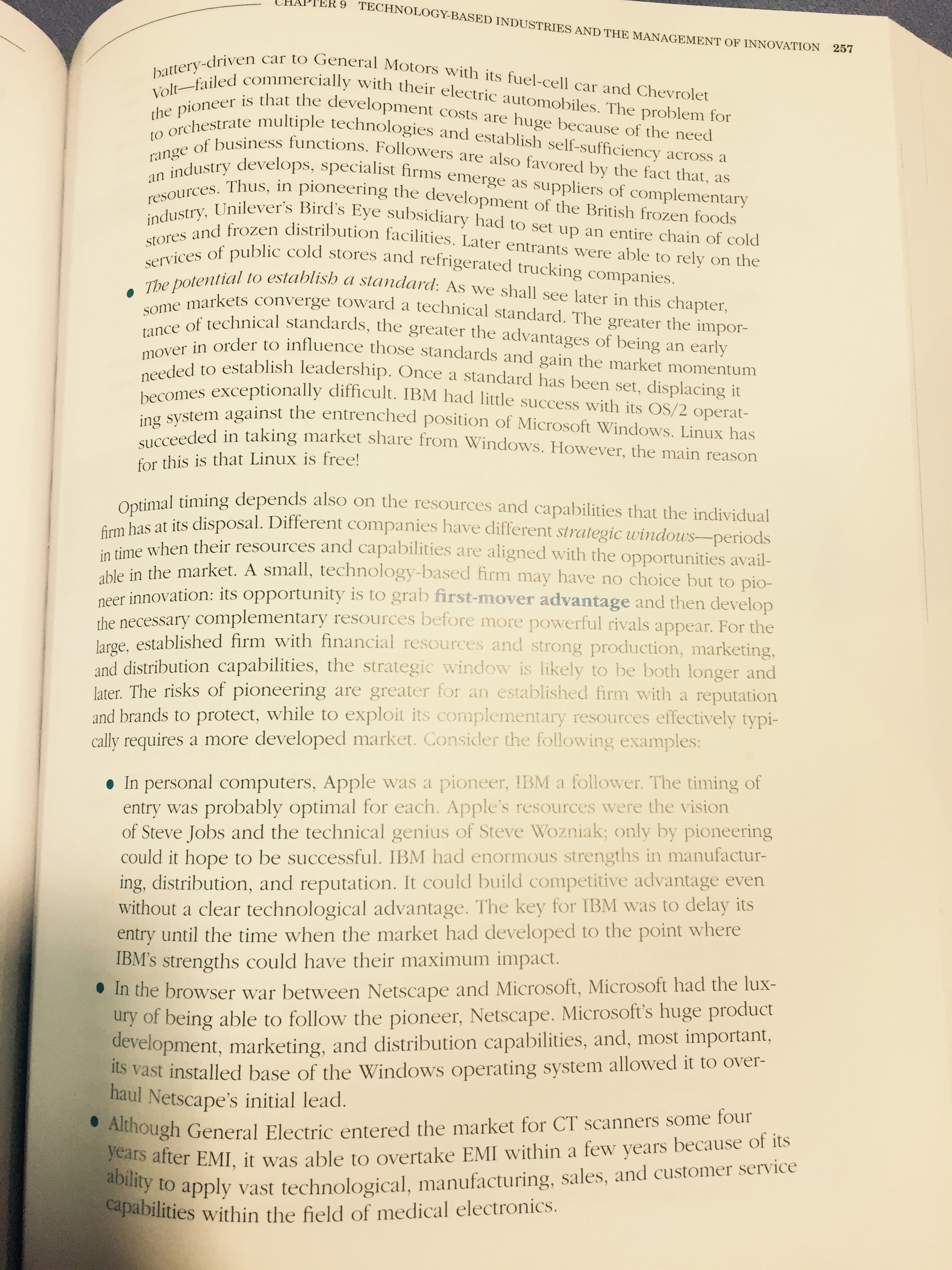Please answer this question using the attached picture of the table from my book. I have also attached what I started to answer question:
From the evidence presented in Table 9.3, what conclusions can you draw regarding the factors that determine whether leaders or followers win out in the markets for new products?
within it. The delayed dination among TV manufacturers, production studios, and broadcasters,8 adequate coor- Timing Innovation: To Lead or to Follow? 10 gain competitive advantage in emerging and technologically intensive industries ; it better to be a leader or a follower in innovation? As Table 9.3 shows, the evident is mixed: in some products the leader has been the first to grab the prize; in others the leader has succumbed to the risks and costs of pioneering. Optimal timing of entry into an emerging industry and the introduction of new technology are complex issues The advantage of being an early mover depends on the following factors: .The extent to which innovation can be protected by property rights or lead- time advantages: If an innovation is appropriable through a patent, copy- right, or lead-time advantage, there is advantage in being an early mover. This is especially the case where patent protection is important, as in phar- maceuticals. Notable patent races include that between Alexander Bell and Elisha Gray to patent the telephone (Bell got to the Patent Office a few hours before Gray),' and between Celera Inc. and the National Institutes of Health to patent the sequence of the human genome. 10 . The importance of complementary resources: The more important comple- mentary resources are in exploiting an innovation, the greater the costs and risks of pioneering. Several firms-from Sir Clive Sinclair with a TABLE 9.3 Leaders, followers, and success in emerging industries Product Innovator Follower The winner Jet airliner De Havilland (Comet) Boeing (707) Follower Float glass Pilkington Corning Leader X-ray scanner EMI General Electric Follower Office PC Xerox IBM Follower VCRS Ampex/Sony Matsushita Follower Instant camera Polaroid Kodak Leader Microwave oven Raytheon Samsung Follower Video games player Atari Disposable diaper Nintendo/Sony Followers Compact disk Procter & Gamble Kimberley-Clark Leader Web browser Sony/Philips Matsushita, Pioneer Leader Web search engine Netscape Microsoft Follower MP3 music players Lycos Google Operating systems for Diamond Multimedia Follower Symbian Apple (iPod) Follower mobile phones Microsoft Leader (until 2010) Laser printer Flash memory Xerox, IBM E-book reader Toshiba Canon Follower Social networking Sony (Digital Reader) Samsung, Intel Followers SixDegrees.com Amazon (Kindle) Follower Facebook (Cambridge: Ballinger, 1987): 186-8. Source: Based in part on D. Teece, The Competitive Challenge: Strategies for Industrial Innovation and Renewal FollowerTECHNOLOGY-BASED INDUSTRIES AND THE MANAGEMENT OF INNOVATION 257 battery-driven car to General Motors with its fuel-cell car and Chevrolet volt-failed commercially with their electric automobiles. The problem for the pioneer is that the development costs are huge because of the need to orchestrate multiple technologies and establish self-sufficiency across a range of business functions. Followers are also favored by the fact that, as an industry develops, specialist firms emerge as suppliers of complementary resources. Thus, in pioneering the development of the British frozen foods industry, Unilever's Bird's Eye subsidiary had to set up an entire chain of cold stores and frozen distribution facilities. Later entrants were able to rely on the services of public cold stores and refrigerated trucking companies. . The potential to establish a standard: As we shall see later in this chapter, some markets converge toward a technical standard. The greater the impor- tance of technical standards, the greater the advantages of being an early mover in order to influen o influence those standards and gain the market momentum needed to establish leadership. Once a standard has been set, displacing it becomes exceptionally difficult. IBM had little success with its OS/2 operat- ing system against the entrenched position of Microsoft Windows. Linux has succeeded in taking market share from Windows. However, the main reason for this is that Linux is free! Optimal timing depends also on the resources and capabilities that the individual firm has at its disposal. Different companies have different strategic windows-periods in time when their resources and capabilities are aligned with the opportunities avail- able in the market. A small, technology-based firm may have no choice but to pio- neer innovation: its opportunity is to grab first-mover advantage and then develop the necessary complementary resources before more powerful rivals appear. For the large, established firm with financial resources and strong production, marketing, and distribution capabilities, the strategic window is likely to be both longer and later. The risks of pioneering are greater for an established firm with a reputation and brands to protect, while to exploit its complementary resources effectively typi- cally requires a more developed market. Consider the following examples: . In personal computers, Apple was a pioneer, IBM a follower. The timing of entry was probably optimal for each. Apple's resources were the vision of Steve Jobs and the technical genius of Steve Wozniak; only by pioneering could it hope to be successful. IBM had enormous strengths in manufactur ing, distribution, and reputation. It could build competitive advantage even without a clear technological advantage. The key for IBM was to delay its entry until the time when the market had developed to the point where IBM's strengths could have their maximum impact. . In the browser war between Netscape and Microsoft, Microsoft had the lux- ury of being able to follow the pioneer, Netscape. Microsoft's huge product development, marketing, and distribution capabilities, and, most important, its vast installed base of the Windows operating system allowed it to over- haul Netscape's initial lead. . Although General Electric entered the market for CT scanners some four years after EMI, it was able to overtake EMI within a few years because of its ability to apply vast technological, manufacturing, sales, and customer service capabilities within the field of medical electronics








